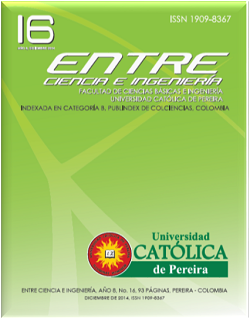Scheme for sizing the sedimentation units in high rate upflow
Keywords:
high rate, inclined plates, sedimentation, laminar sedimentation, wastewater treatment, advanced primary treatmentAbstract
In this article a systematic methodological approach for the design of sedimentation units high rate upflow inclined plates is formulated. It uses the guidelines and the existing equations in the literature. The development raised to define appropriate values for surface charge (Cs) and ratio of plate length and distance between plates (l / d), which meet the guidelines for surface charge (Cs), retention time plates (tp), reason plate between length and distance between plates (l / d), and settlement critical speed (Vsc). The implementation of this methodology has benefits such as: i) indicate a clear order of the calculations that lead to meet the guidelines of the literature, without the need of trial and error, ii) indicate the permissible limits of user-defined variables. The example shows that the proposed plan may be simply carried to a computer, and the information generated by the computer allows for easy, quick and proper definition of the user-selected variables.
References
D. Robescu, C. Mandis, y D. Robescu. ‘‘Design lamellar secondary settling tank using numerical modeling,’’ UPB Sci. Bull. Series D, vol. 72, no. 04, pp. 211-216, 2010.
C. Desjardins, B. Koudjonou, y R. Desjardins. ‘‘Laboratory study of ballasted flocculation,’’ Wat. Res., vol. 36, no. 03, pp. 744-754, 2002.
JD. Henao, y GC. Isaza, Diseño y Construcción de una Unidad de Banco para Coagulación, Floculación y Sedimentación. Manizales: Universidad Nacional de Colombia Sede Manizales, 2004.
JA. Romero, Purificación del Agua. Bogotá: Escuela Colombiana de Ingeniería, 2006.
J. Arboleda, Teoría y Práctica de la Purificación del Agua. Bogotá: Asociación Colombiana de Ingeniería Sanitaria y Ambiental, 1992.
JA. Pérez, Manual de Potabilización del Agua. Medellín: Universidad Nacional de Colombia sede Medellín, 1997.
A. Hernandez, Depuración de Aguas Residuales. Madrid: Colegio de Ingenieros de Caminos, Canales y Puertos, 1992.
G. Rivas, Tratamiento de Aguas Residuales. Caracas: Ediciones Vega, 1978.
A. Demir. ‘‘Determination of settling efficiency and optimum plate angle for plated settling tanks,’’ Wat. Res., vol. 29, no. 02, pp. 611- 616, 1995.
O. Lekang, AM. Bomo, y I. Svendsen. ‘‘Biological lamella sedimentation used for wastewater treatment,’’ Aquacultural Eng., vol. 24, no. 02, pp. 115-127, Feb. 2001
J. Gasperi, V. Rocher, S. Gilbert, S. Azimi, y G. Chebbo. ‘‘Occurrence and removal of priority pollutants by lamella clarification and biofiltration,’’ Wat. Res., vol. 44, no. 10, pp. 3065-3076, 2010.
J. Wood, S. Dhanvantari, M. Yang, Q. Rochfort, P. Chessie, J. Marsalek, S. Kok, y P. Seto. ‘‘Feasibility of stormwater treatment by conventional and lamellar settling with and without polymeric flocculant addition,’’ Wat. Qual. Res. J. Canada, vol. 39, no. 04, pp. 406-416, 2004.
R. Braga y S. Conceicao. ‘‘Mathematical modeling and analysis of the flocculation process in chambers in series,’’ Bioprocess. Biosyst. Eng., vol. 36, no.03, pp. 357-363, 2013.
EP. Tangerino, ‘‘Floculador de manta de lodo asociado a decantador laminar en tratamento de agua,’’ presentado en el Congreso Interamericano de Ingeniería Sanitaria y Ambiental (AIDS), Lima, Peru, Nov. 01-05, 1998.








 Revista Entre Ciencia e Ingeniería
Revista Entre Ciencia e Ingeniería .png) entrecei@ucp.edu.co
entrecei@ucp.edu.co.png) ISSN (Impreso) 1909-8367 - ISSN (En Línea) 2539-4169
ISSN (Impreso) 1909-8367 - ISSN (En Línea) 2539-4169 Attribution-NonCommercial 4.0 International (CC By-NC 4.0)
Attribution-NonCommercial 4.0 International (CC By-NC 4.0)
.png) Carrera 21 No. 49-95 Av. de las Américas, Pereira, Risaralda, Colombia
Carrera 21 No. 49-95 Av. de las Américas, Pereira, Risaralda, Colombia